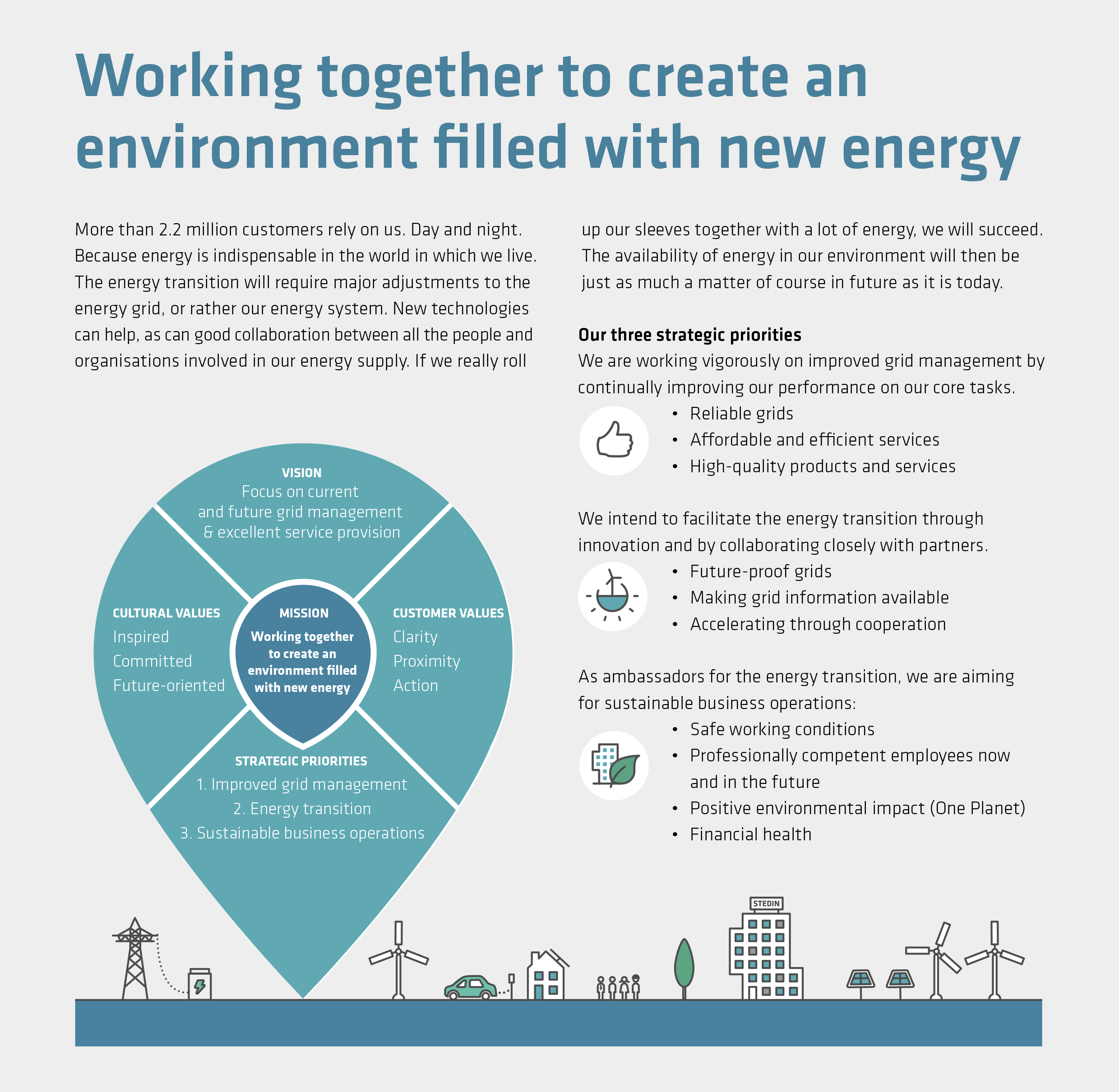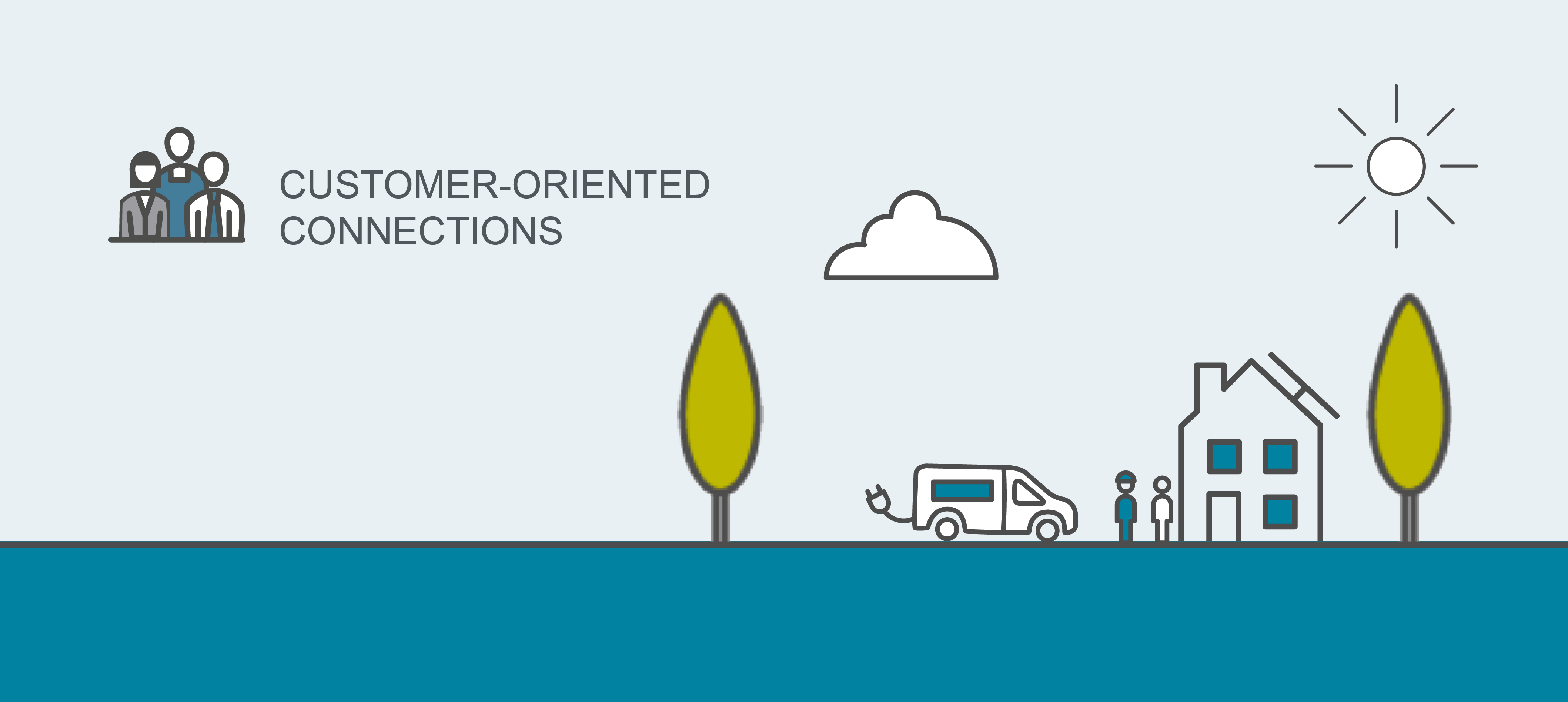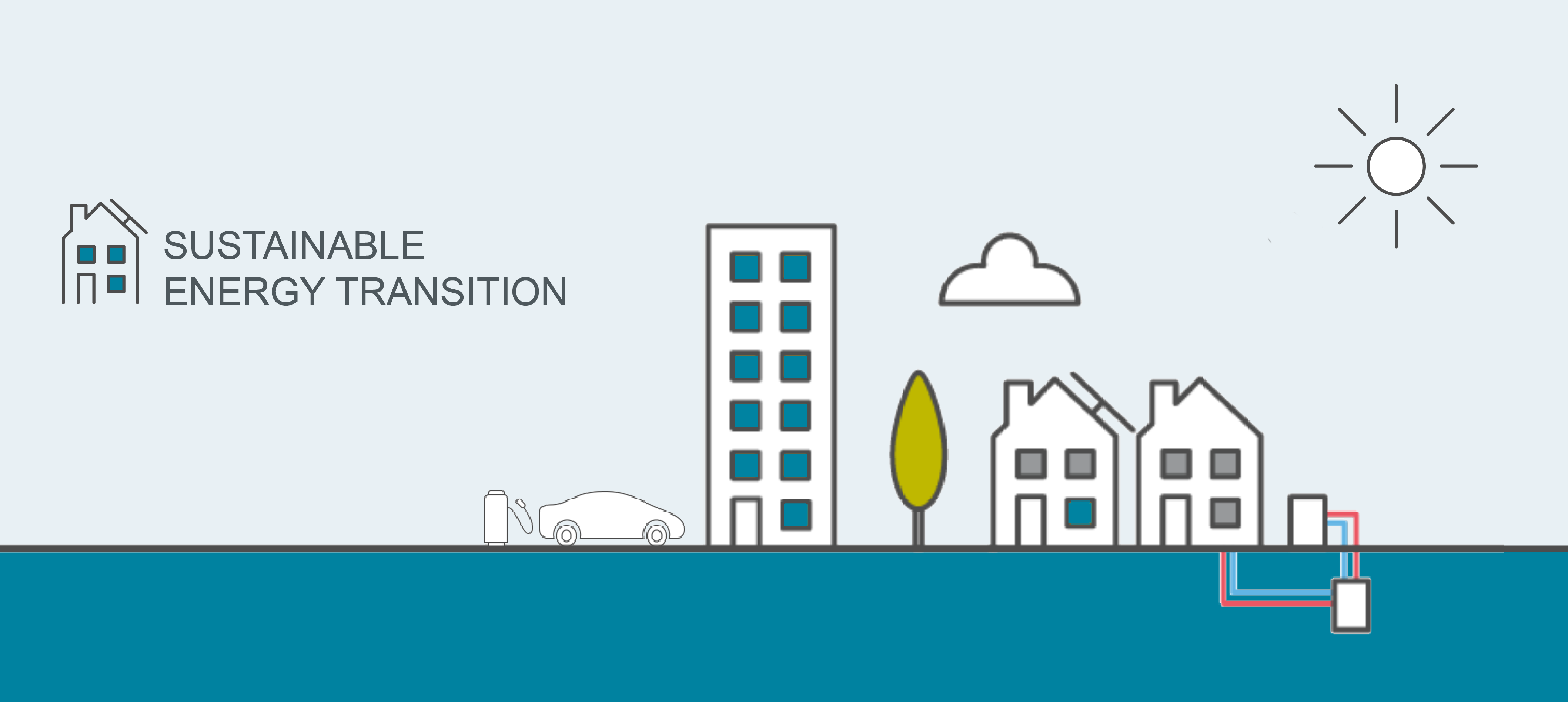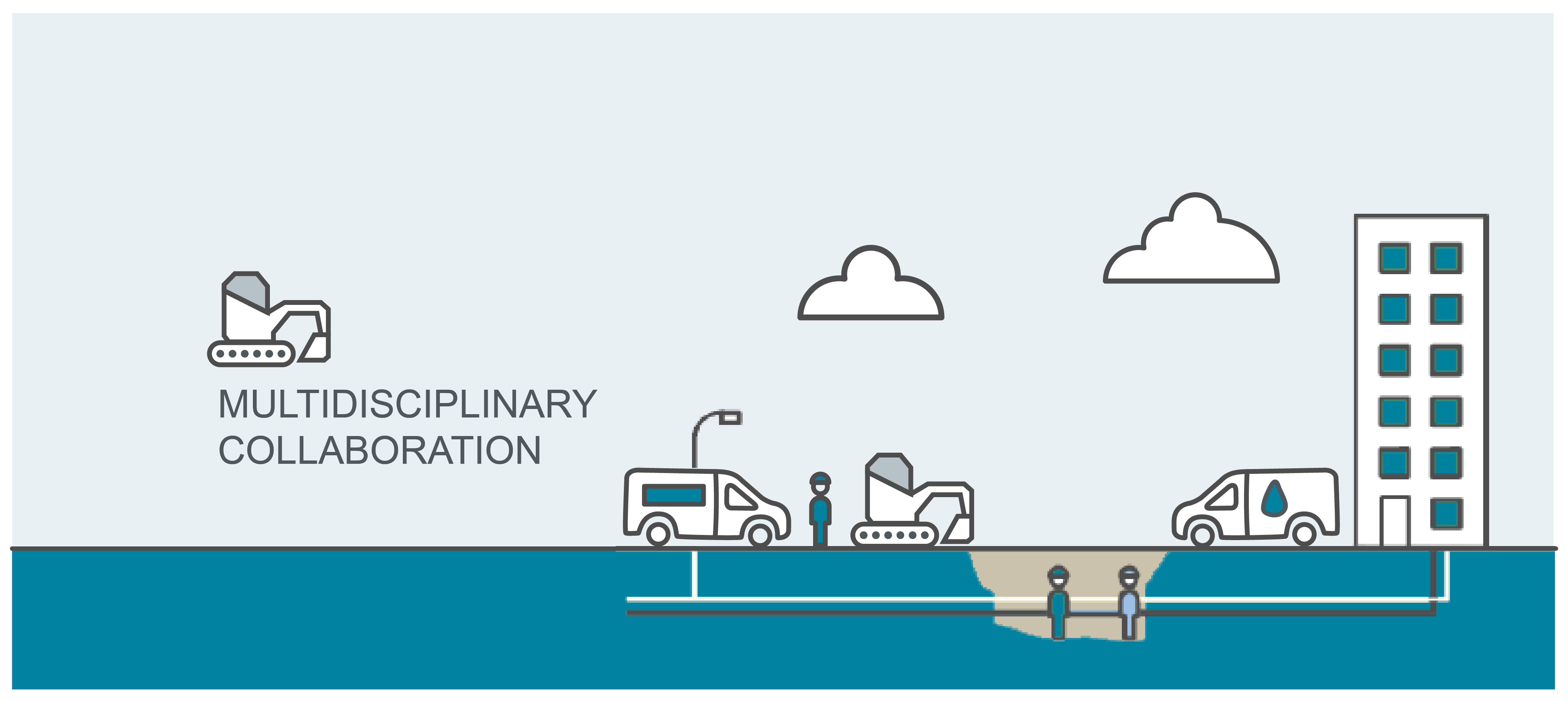Mission, vision and strategy
Working together to create an environment filled with new energy. That is our mission. We believe that we can make the energy transition possible by focusing on our core tasks for grid management, both now and in the future, and delivering an excellent service for our customers. We have identified three strategic spearheads: improved grid management, facilitating the energy transition and sustainable business operations.
We are working day and night on a future-proof grid. We are investing in the infrastructure that is needed to connect solar and wind farms as well as to transmit the electricity that is generated; to heat districts when they switch to a heat grid or a supply with (hybrid) heat pumps; and to enable the increasing numbers of electric cars to charge or discharge their batteries. We are investing in making our electricity grid smarter to give us greater insight into the energy flowing through the grid and to help us rectify faults more quickly. This insight also improves our capacity to predict and manage, so we can make optimal use of the capacity of the electricity grid and so the voltage quality is maintained. Making it smarter also means using the existing infrastructure differently – for instance, by using the gas grids for sustainable gases such as hydrogen. This process will help to ensure that the transition remains affordable.
It is our ambition to be the most customer-focused, operationally efficient and sustainable grid manager by 2025. By that time, customers will be able to choose the timing of connection themselves and transact with us effortlessly, we will manage new heat and electricity grids, roads will only need to be dug up once, because we will coordinate our activities with the water companies, and our gas grid will be given a new lease of life with hydrogen and green gas.
Strategic challenges
Our strategic challenges remain unchanged compared to the previous year: to improve the quality of our services, to retain our financial health going forward and to cope with the combination of an increasing volume of work and increasing scarcity in the labour market.
Improving the quality of services
We are already doing well in many aspects, but we should still improve. Alongside appreciation of the work we do and the high reliability of our grids, there is also criticism, and we need to be honest about that. We continuously monitor where we can make improvements. One example is the time it takes to establish new connections to our grids. Communication regarding schedules or changes concerning connections also needs to be improved. We can work faster as well as more efficiently for our customers by organising our services more intelligently.
The energy transition and high energy demand have an impact on our services. Anyone wanting to construct new facilities or set up a connection is free to do so, even if the available capacity of the grid is limited at that spot. It is essential to look and plan ahead together in order to ensure that sufficient grid capacity remains available. At the same time, there is a growing realisation that not everything is possible: choices need to be made. For this reason, we engage with customers and other local and regional parties. We hold extensive discussions and prioritise the customer more than ever. Our engagement enables us to make our products and services more finely tuned to customers' wishes. We furthermore endeavour, as far as possible, to craft a smart and digital approach to work. Our active involvement in the Regional Energy Strategies and the Regional Agenda on the Charging Infrastructure Network enables us to anticipate where our investments should be made. This provides a sound basis for further improving the quality of our services and facilitating the energy transition.
Retaining financial health going forward
The energy transition is a major challenge for the Netherlands, with abundant dynamism. Decisions are constantly being made: at the regional level by municipalities in discussions on the Regional Energy Strategies, at the national level by the government and at the international level as well, as shown in the decision of the European Commission to cut net greenhouse gas emissions by at least 55% by 2030. Our investment programme is updated at regular intervals in the light of all the latest insights. This has resulted in us committing to invest approximately €7 billion between 2020 and 2030 to facilitate the energy transition in our service area. This is an increase on previous forecasts. The precise investments made in the future will depend on the choices that are made, customer demand and the speed with which the energy transition advances. The question we therefore need to answer is how to remain financially healthy against this background.
The present regulatory model takes insufficient account of the changing environment in which grid managers operate and does not provide for a reduced payback period of investments. This situation places a heavy demand on our financial position. Currently, finances are too constrained to allow all the investments to be made that are necessary for the energy transition from a social perspective.
Capital requirement
Continuing social acceptance is crucial in the drive to achieve the energy transition. This is only possible if we are transparent about the costs and benefits of the transition and we remain in dialogue with one another about how we intend to shoulder the burden as a society. In addition to the loans we raise, Stedin Group expects that it will need an additional €750 million to €1 billion in equity in the years until 2030 to keep the societal costs at an affordable level. The grid manager's total capital requirement depends on the speed of the energy transition, the future regulatory regime and the level of rates. The money is intended, among other things, for reinforcing and reconfiguring our grids as well as for building new infrastructure. This can only be achieved together with all our stakeholders. The following is a summary of what we are doing to retain our financial health in the long term:
- More efficient working practices to save costs
We begin by analysing everything that we could be doing, and that is within our control, to be effective and efficient. For instance, we critically examine our investments and their timing, and in 2018, we launched a five-year efficiency programme aimed at reducing our operating expenses by €150 million. Of this figure, €109 million had been achieved by the end of 2020. In 2020, we reviewed the efficiency programme and raised our ambition to €180 million. In addition, the programme was extended to expire in 2025 instead of 2022, driven in particular by our success in achieving the savings to date. In 2021, we will consider which additional steps we can take until the end of the forthcoming regulation framework in 2026. Although we retain a sharp focus on continuous efficiency improvements, this will not be sufficient to finance all the investments necessary for the energy transition. - Dialogue with the ACM about regulation
We are in close consultation with the regulator ACM about modifying the regulatory regime used for the next regulation period (which will commence in 2022). Grid managers are seeking sufficient financial scope within the regulation framework to permit all the necessary investments. This is too limited at present, in particular as the financial scope for the coming period is largely based on the situation in recent years. Briefly put, the current regulatory regime is based on the situation prior to the energy transition and not on the challenges of tomorrow. The aim is to ensure that Stedin Group's income more closely matches its costs. This is a joint undertaking with the other regional grid managers. - Strengthening our equity capital base
We are exploring opportunities for expanding our financial scope for investments in the energy system by asking for equity capital contributions from the current shareholders or possibly other parties (new public shareholders, including municipalities and provinces, as well as central government). Strengthening our equity capital base will allow us to maintain a healthy credit rating, which is seen as an indication of reliability on the financial markets, so that the cost of lending for investments does not become unnecessarily expensive. In 2020, we held intensive discussions with our shareholders about our long-term financing and a potential contribution in the short and long term. - Exploring potential solutions together
The grid managers are working together to provide greater financial scope for investments. In this way, the grid managers are bringing together relevant stakeholders to jointly explore new potential solutions. These may include capital injections, subsidies from public authorities or legislative and regulatory amendments for the next regulation period. The stakeholders concerned are the Ministry of Economic Affairs and Climate Policy and the Ministry of Finance, the regulator ACM and the interest groups the Association of Netherlands Municipalities (VNG) and the Association of Provincial Authorities (IPO) (as representatives of shareholders who also have regional control over the energy transition).
And what if we do not succeed in strengthening our financial position? In that event, we could end up in a scenario where we are unable to make the necessary investments to achieve the desired progress with the energy transition. Or a scenario in which we need to borrow more, resulting in a lower rating and higher interest charges, which may also potentially have an impact on the level of necessary investments we can make. Neither scenario is desirable, in our opinion. The policy choices we make today provide the basis for fulfilling our role in the energy transition in several years' time. It is important to do this together and from a financially healthy perspective.
Workload is increasing, scarcity in the labour market
The energy transition is in full swing, and this has implications for Stedin. It means a sharp rise in the number of new connections and grid reinforcements. We are closely involved in various partnerships where choices are made and have to analyse the different scenarios, including the impact they have on our grids. The energy transition also requires grid managers to play a greater role in making data accessible, and substantial input is needed from Stedin in the debate on energy policy, market regulation of heat and hydrogen, for example, and financing the energy transition. This challenge has an impact on how we should shape our workforce.
In order to have a clear understanding of the current and necessary future capacity and competences, we set up a system of strategic personnel planning in 2019. We made good use of the first insights this yielded in 2020. Thanks to the fine work being done by our in-house training school, we know that we have enough junior fitters. At the same time, there is a growing shortage in trained intermediate and more specialised technical roles and in the area of IT. These insights have enabled us to refine our planning to permit greater differentiation in terms of current and future colleagues and to concentrate on recruitment and internal advancement.


Strategic initiatives
Within our strategic spearheads 'Improved grid management' and 'Facilitating the energy transition', we are focusing on four change projects that will contribute significantly to delivering our strategy. They are: Customer-oriented connections, Multidisciplinary collaboration, Sustainable energy transition and System operator.

1. Customer-oriented connections; on time and tailor-made at the lowest societal costs
By implementing digitalisation as much as possible, among other things, we aim for improved lead times of connections by the end of 2022: we intend to connect 80% of our customers within four weeks, if the customer wishes. We are also aiming for a customer satisfaction score of 80% and a 40% increase in productivity. The result will be that satisfied customers receive a tailor-made service on time and at the lowest possible societal costs.

3. Sustainable energy transition; ready for the future
To achieve the goals of the climate agreement, we are preparing, as a grid manager, for a future with a new energy system. The sustainable energy transition strategic initiative is aimed at embedding the new working practices in the Stedin organisation. This enables us to predict grid capacity and create future scenarios. We are also engaged in close dialogue with stakeholders.

2. Multidisciplinary; efficiency and customer satisfaction go hand in hand
A multidisciplinary way of working is aimed at developing cooperation with other parties, such as the drinking water companies in our service area. As we all work below ground, a multidisciplinary approach to working enables us to carry out our work more efficiently, achieve savings, make better use of scarce personnel and reduce inconvenience for local residents.

4. System operator; overseeing and directing the energy system
Within this initiative, we are expanding our role as a manager of physical grids with the management of digital data flows. We are exchanging increasing amounts of data with customers, municipalities, market parties and other grid managers on a range of topics, such as available grid capacity. This expanding role in overseeing and directing the energy system means we are becoming a system operator.
Interview with Jeroen Grond, director of Safety and crisis team chair (SST)
'The greatest risk? That 30% of staff might not be able to come to work.'
It has been a hectic period for Stedin Group's crisis team: for months on end, it put in long days to ensure the organisation could cope effectively with all the challenges of COVID-19. 'Stedin plays an important role in keeping the critical infrastructure in the Netherlands functioning.'
‘I can still remember it clearly’, says Jeroen Grond, director of Safety, on behalf of the crisis team. 'It was a Saturday evening in mid-February when our colleagues at Enexis raised the alarm internally. The first coronavirus cases had been recorded in the province of North Brabant, and the situation did not look good. This was the trigger for us at Stedin to start working on our coronavirus contingency plans.' The greatest risk? 'That 30% of staff might not be able to come to work, with all the accompanying adverse effects on our services. We quickly scaled up the crisis organisation to level 3. This is the second-highest level in the crisis plan, which we had never previously had to activate at Stedin. In practical terms, it meant that a crisis team was formed that assumed overall control, whilst the regular crisis organisation continued as before, to deal with failures, for example. The confidence that the Board of Management immediately placed in us was and remains immense.'
Even before Prime Minister Mark Rutte gave his first COVID-19 press conference, Stedin was already well advanced in its preparations. This is important, given Stedin's responsibility for critical infrastructure. It was quickly decided, for example, not to carry out any work nearby hospitals, to avoid any risk of failures or power outages affecting them. Maintaining supply security, ensuring the safety of our workers and continuity were priority considerations in every discussion. Jeroen recounts, 'We kept asking: how well prepared are we? Where can we spot potential issues? And how do we distinguish an incident from a problem?' The team was able to resolve essential issues even before the press conference took place. 'For example, we "only" had 1,000 VPN connections. That would have been plenty under normal circumstances, but now the entire company had to work from home. IT doubled this number in the space of a single weekend and then quickly ramped up to 4,000 connections. That is quite an accomplishment.' In addition, a dashboard was immediately set up as well as a project team, to monitor information and facilitate quick decision-making.
The first 24 hours
Thanks to the preparations, the first 24 hours passed by without much incident. 'We are responsible for critical infrastructure, so we are by nature crisis managers. It is part and parcel of who we are. We involved the works council and made clear communication a priority. It is impossible to overstate how important this is. If people understand why they need to do something, they are more likely to support difficult measures. We explained what behaviours we needed to adopt, which work had priority and what could wait, and we issued regular updates. There was a great sense of solidarity, and everyone helped out. It was very quickly decided across the industry to temporarily suspend all work involving smart meters. The in-house training school also closed its doors, and our control room teams were spread over two locations, as a precaution. 'A whole apparatus swung into action. Fitters who would normally install the smart meters brought keyboards, screens, computer mouses and chairs to colleagues working from home. At the office, everything was rearranged in line with the 1.5-metre social distancing rules – notwithstanding the rule that people should work from home if possible. Field staff were issued with coronavirus kits, including PPE to be worn when entering customers' homes. In the beginning, we met seven times a week, although we gradually scaled this back.'
Tough decisions
As you would expect, every crisis situation is accompanied by some tough decision-making. 'Personal situations are the most difficult. Take the example of an employee with 40 years' service who is denied a proper farewell. I find this really difficult, but it's just not possible in the present circumstances.' Another painful episode was when a colleague's wife died of the coronavirus. 'Just terrible. His fellow workers lined the route of the funeral procession with Stedin vans, to pay their last respects. The sense of solidarity is incredible at times like this.'
During the coronavirus period, there was a continuous flow of new areas for attention. 'These mainly related to additional assistance for employees: confidential counsellors, an HR coronavirus helpdesk, leadership training. As colleagues, we also got together to donate EUR 19,500 to the food bank.' Financially, the coronavirus has had an adverse impact, with production losses.' Still, there are also some bright spots: 'The unselfish cooperation, with everyone pulling together and lending a hand. The interest of Stedin as a whole is more important than the interest of any individual department.'
